Colombian vs Shoshone Community Comparison
COMPARE
Colombian
Shoshone
Social Comparison
Social Comparison
Colombians
Shoshone
5,155
SOCIAL INDEX
49.1/ 100
SOCIAL RATING
184th/ 347
SOCIAL RANK
2,256
SOCIAL INDEX
20.1/ 100
SOCIAL RATING
264th/ 347
SOCIAL RANK
Shoshone Integration in Colombian Communities
The statistical analysis conducted on geographies consisting of 62,141,858 people shows a mild negative correlation between the proportion of Shoshone within Colombian communities in the United States with a correlation coefficient (R) of -0.385. On average, for every 1% (one percent) increase in Colombians within a typical geography, there is a decrease of 0.010% in Shoshone. To illustrate, in a geography comprising of 100,000 individuals, a rise of 1,000 Colombians corresponds to a decrease of 10.0 Shoshone.
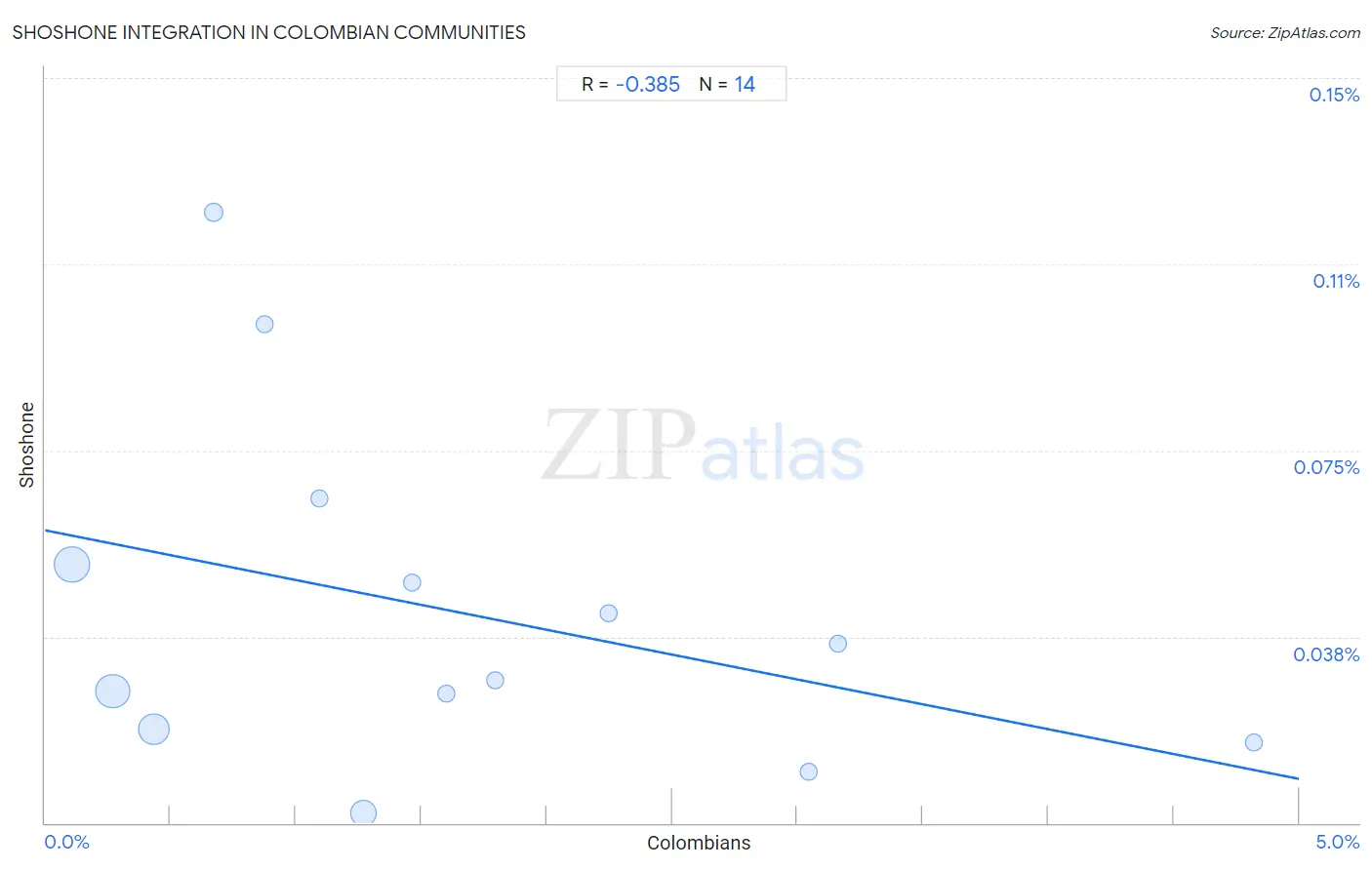
Colombian vs Shoshone Income
When considering income, the most significant differences between Colombian and Shoshone communities in the United States are seen in householder income ages 45 - 64 years ($99,772 compared to $83,588, a difference of 19.4%), median household income ($85,716 compared to $72,660, a difference of 18.0%), and per capita income ($43,661 compared to $37,072, a difference of 17.8%). Conversely, both communities are more comparable in terms of wage/income gap (24.7% compared to 25.4%, a difference of 2.9%), householder income under 25 years ($53,357 compared to $48,720, a difference of 9.5%), and householder income over 65 years ($58,851 compared to $53,681, a difference of 9.6%).

| Income Metric | Colombian | Shoshone |
| Per Capita Income | Average $43,661 | Tragic $37,072 |
| Median Family Income | Fair $100,750 | Tragic $87,872 |
| Median Household Income | Average $85,716 | Tragic $72,660 |
| Median Earnings | Average $46,349 | Tragic $40,932 |
| Median Male Earnings | Fair $53,832 | Tragic $47,930 |
| Median Female Earnings | Fair $39,439 | Tragic $34,677 |
| Householder Age | Under 25 years | Exceptional $53,357 | Tragic $48,720 |
| Householder Age | 25 - 44 years | Average $94,565 | Tragic $82,062 |
| Householder Age | 45 - 64 years | Average $99,772 | Tragic $83,588 |
| Householder Age | Over 65 years | Tragic $58,851 | Tragic $53,681 |
| Wage/Income Gap | Exceptional 24.7% | Good 25.4% |
Colombian vs Shoshone Poverty
When considering poverty, the most significant differences between Colombian and Shoshone communities in the United States are seen in single father poverty (16.1% compared to 22.9%, a difference of 42.5%), single male poverty (12.2% compared to 16.7%, a difference of 37.1%), and female poverty among 18-24 year olds (17.7% compared to 22.5%, a difference of 27.4%). Conversely, both communities are more comparable in terms of seniors poverty over the age of 65 (12.5% compared to 12.3%, a difference of 1.3%), receiving food stamps (12.6% compared to 12.4%, a difference of 2.1%), and seniors poverty over the age of 75 (14.3% compared to 13.1%, a difference of 9.0%).
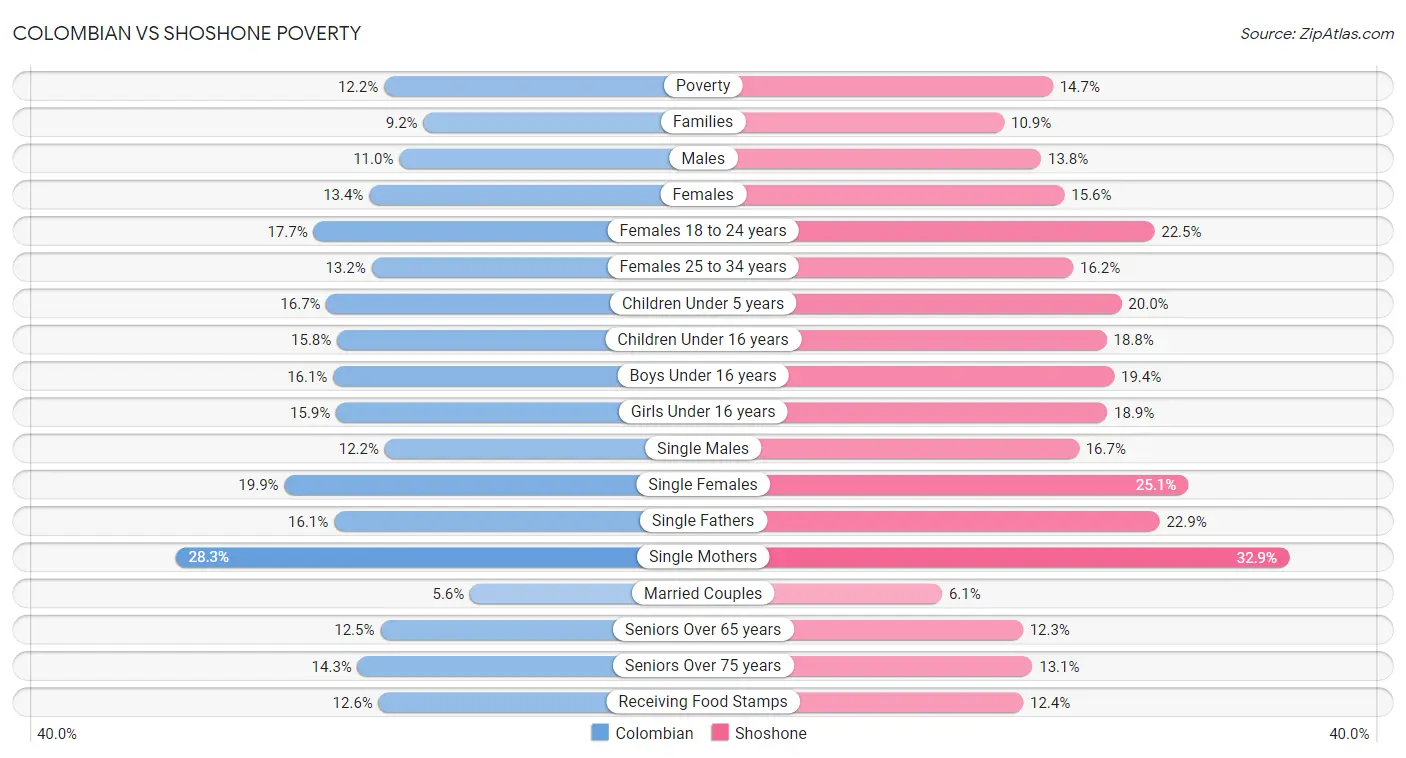
| Poverty Metric | Colombian | Shoshone |
| Poverty | Average 12.2% | Tragic 14.7% |
| Families | Fair 9.2% | Tragic 10.9% |
| Males | Good 11.0% | Tragic 13.8% |
| Females | Average 13.4% | Tragic 15.6% |
| Females 18 to 24 years | Exceptional 17.7% | Tragic 22.5% |
| Females 25 to 34 years | Good 13.2% | Tragic 16.2% |
| Children Under 5 years | Good 16.7% | Tragic 20.0% |
| Children Under 16 years | Good 15.8% | Tragic 18.8% |
| Boys Under 16 years | Good 16.1% | Tragic 19.4% |
| Girls Under 16 years | Good 15.9% | Tragic 18.9% |
| Single Males | Exceptional 12.2% | Tragic 16.7% |
| Single Females | Exceptional 19.9% | Tragic 25.1% |
| Single Fathers | Good 16.1% | Tragic 22.9% |
| Single Mothers | Exceptional 28.3% | Tragic 32.9% |
| Married Couples | Tragic 5.6% | Tragic 6.1% |
| Seniors Over 65 years | Tragic 12.5% | Tragic 12.3% |
| Seniors Over 75 years | Tragic 14.3% | Tragic 13.1% |
| Receiving Food Stamps | Poor 12.6% | Poor 12.4% |
Colombian vs Shoshone Unemployment
When considering unemployment, the most significant differences between Colombian and Shoshone communities in the United States are seen in unemployment among women with children under 6 years (7.5% compared to 13.2%, a difference of 75.8%), unemployment among ages 55 to 59 years (4.7% compared to 7.4%, a difference of 55.6%), and unemployment among ages 30 to 34 years (5.4% compared to 7.9%, a difference of 46.9%). Conversely, both communities are more comparable in terms of unemployment among seniors over 75 years (8.5% compared to 8.6%, a difference of 1.1%), unemployment among ages 16 to 19 years (18.3% compared to 19.3%, a difference of 5.7%), and unemployment among women with children ages 6 to 17 years (9.3% compared to 10.0%, a difference of 6.6%).
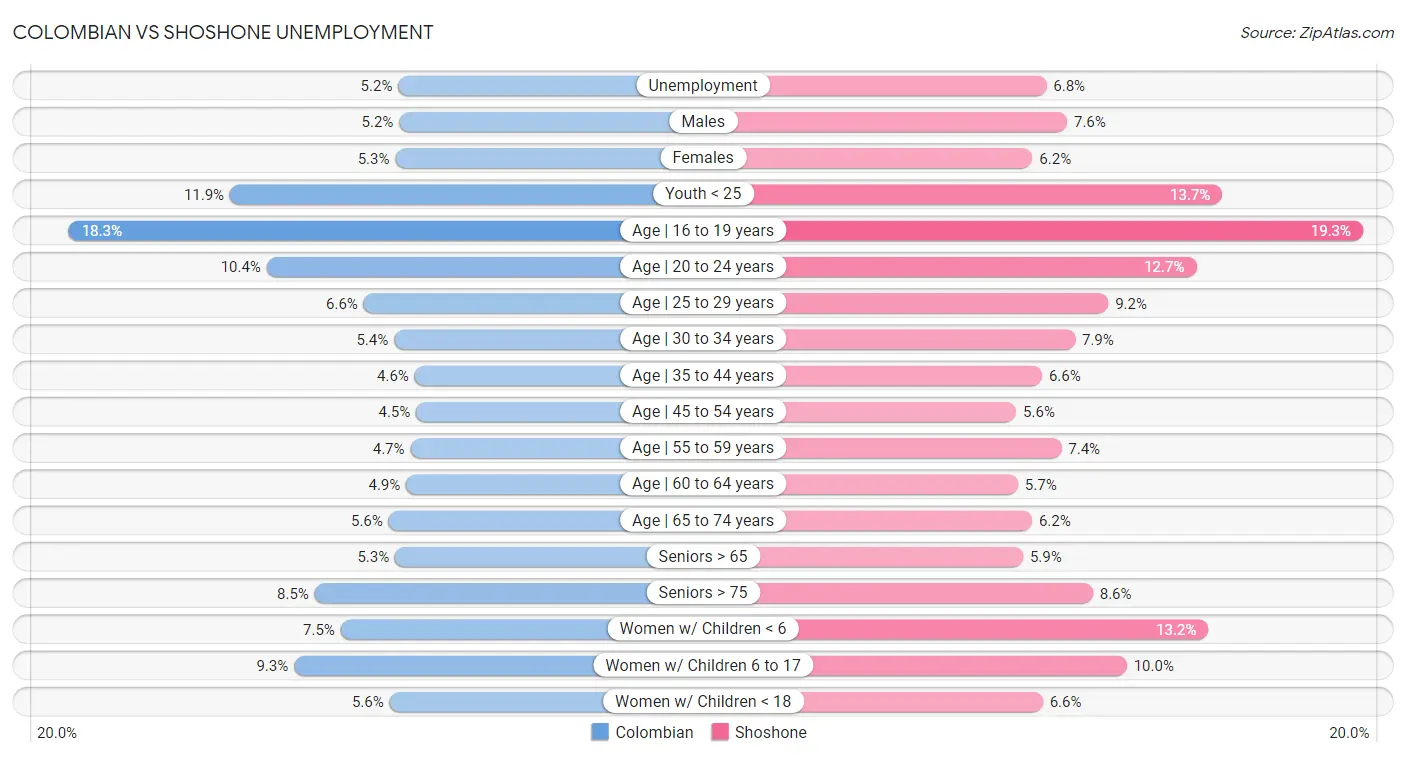
| Unemployment Metric | Colombian | Shoshone |
| Unemployment | Good 5.2% | Tragic 6.8% |
| Males | Excellent 5.2% | Tragic 7.6% |
| Females | Fair 5.3% | Tragic 6.2% |
| Youth < 25 | Tragic 11.9% | Tragic 13.7% |
| Age | 16 to 19 years | Tragic 18.3% | Tragic 19.3% |
| Age | 20 to 24 years | Fair 10.4% | Tragic 12.7% |
| Age | 25 to 29 years | Good 6.6% | Tragic 9.2% |
| Age | 30 to 34 years | Good 5.4% | Tragic 7.9% |
| Age | 35 to 44 years | Excellent 4.6% | Tragic 6.6% |
| Age | 45 to 54 years | Average 4.5% | Tragic 5.6% |
| Age | 55 to 59 years | Excellent 4.7% | Tragic 7.4% |
| Age | 60 to 64 years | Fair 4.9% | Tragic 5.7% |
| Age | 65 to 74 years | Tragic 5.6% | Tragic 6.2% |
| Seniors > 65 | Tragic 5.3% | Tragic 5.9% |
| Seniors > 75 | Excellent 8.5% | Good 8.6% |
| Women w/ Children < 6 | Good 7.5% | Tragic 13.2% |
| Women w/ Children 6 to 17 | Tragic 9.3% | Tragic 10.0% |
| Women w/ Children < 18 | Fair 5.6% | Tragic 6.6% |
Colombian vs Shoshone Labor Participation
When considering labor participation, the most significant differences between Colombian and Shoshone communities in the United States are seen in in labor force | age 16-19 (33.8% compared to 39.3%, a difference of 16.1%), in labor force | age 45-54 (83.4% compared to 79.3%, a difference of 5.2%), and in labor force | age 20-64 (80.1% compared to 76.8%, a difference of 4.4%). Conversely, both communities are more comparable in terms of in labor force | age 35-44 (85.0% compared to 82.2%, a difference of 3.4%), in labor force | age 20-24 (73.5% compared to 76.1%, a difference of 3.5%), and in labor force | age 25-29 (84.7% compared to 81.6%, a difference of 3.8%).

| Labor Participation Metric | Colombian | Shoshone |
| In Labor Force | Age > 16 | Exceptional 65.9% | Tragic 63.2% |
| In Labor Force | Age 20-64 | Exceptional 80.1% | Tragic 76.8% |
| In Labor Force | Age 16-19 | Tragic 33.8% | Exceptional 39.3% |
| In Labor Force | Age 20-24 | Tragic 73.5% | Exceptional 76.1% |
| In Labor Force | Age 25-29 | Good 84.7% | Tragic 81.6% |
| In Labor Force | Age 30-34 | Excellent 84.9% | Tragic 81.4% |
| In Labor Force | Age 35-44 | Exceptional 85.0% | Tragic 82.2% |
| In Labor Force | Age 45-54 | Exceptional 83.4% | Tragic 79.3% |
Colombian vs Shoshone Family Structure
When considering family structure, the most significant differences between Colombian and Shoshone communities in the United States are seen in divorced or separated (12.4% compared to 14.0%, a difference of 13.4%), single father households (2.3% compared to 2.6%, a difference of 12.0%), and births to unmarried women (32.2% compared to 35.3%, a difference of 9.5%). Conversely, both communities are more comparable in terms of single mother households (6.6% compared to 6.8%, a difference of 3.5%), average family size (3.26 compared to 3.37, a difference of 3.5%), and family households (66.3% compared to 63.8%, a difference of 3.8%).

| Family Structure Metric | Colombian | Shoshone |
| Family Households | Exceptional 66.3% | Tragic 63.8% |
| Family Households with Children | Exceptional 28.3% | Tragic 26.5% |
| Married-couple Households | Good 46.8% | Tragic 43.9% |
| Average Family Size | Excellent 3.26 | Exceptional 3.37 |
| Single Father Households | Average 2.3% | Tragic 2.6% |
| Single Mother Households | Poor 6.6% | Tragic 6.8% |
| Currently Married | Fair 46.3% | Tragic 44.0% |
| Divorced or Separated | Tragic 12.4% | Tragic 14.0% |
| Births to Unmarried Women | Fair 32.2% | Tragic 35.3% |
Colombian vs Shoshone Vehicle Availability
When considering vehicle availability, the most significant differences between Colombian and Shoshone communities in the United States are seen in 4 or more vehicles in household (5.5% compared to 8.8%, a difference of 59.7%), 3 or more vehicles in household (17.8% compared to 24.9%, a difference of 40.0%), and 2 or more vehicles in household (52.9% compared to 57.9%, a difference of 9.5%). Conversely, both communities are more comparable in terms of 1 or more vehicles in household (88.0% compared to 89.5%, a difference of 1.7%), no vehicles in household (10.0% compared to 10.8%, a difference of 7.7%), and 2 or more vehicles in household (52.9% compared to 57.9%, a difference of 9.5%).

| Vehicle Availability Metric | Colombian | Shoshone |
| No Vehicles Available | Good 10.0% | Fair 10.8% |
| 1+ Vehicles Available | Tragic 88.0% | Fair 89.5% |
| 2+ Vehicles Available | Tragic 52.9% | Exceptional 57.9% |
| 3+ Vehicles Available | Tragic 17.8% | Exceptional 24.9% |
| 4+ Vehicles Available | Tragic 5.5% | Exceptional 8.8% |
Colombian vs Shoshone Education Level
When considering education level, the most significant differences between Colombian and Shoshone communities in the United States are seen in professional degree (4.6% compared to 3.3%, a difference of 39.2%), master's degree (15.3% compared to 11.1%, a difference of 37.5%), and bachelor's degree (38.4% compared to 29.3%, a difference of 31.2%). Conversely, both communities are more comparable in terms of 12th grade, no diploma (90.4% compared to 90.5%, a difference of 0.040%), high school diploma (88.1% compared to 88.3%, a difference of 0.24%), and nursery school (97.7% compared to 98.3%, a difference of 0.66%).
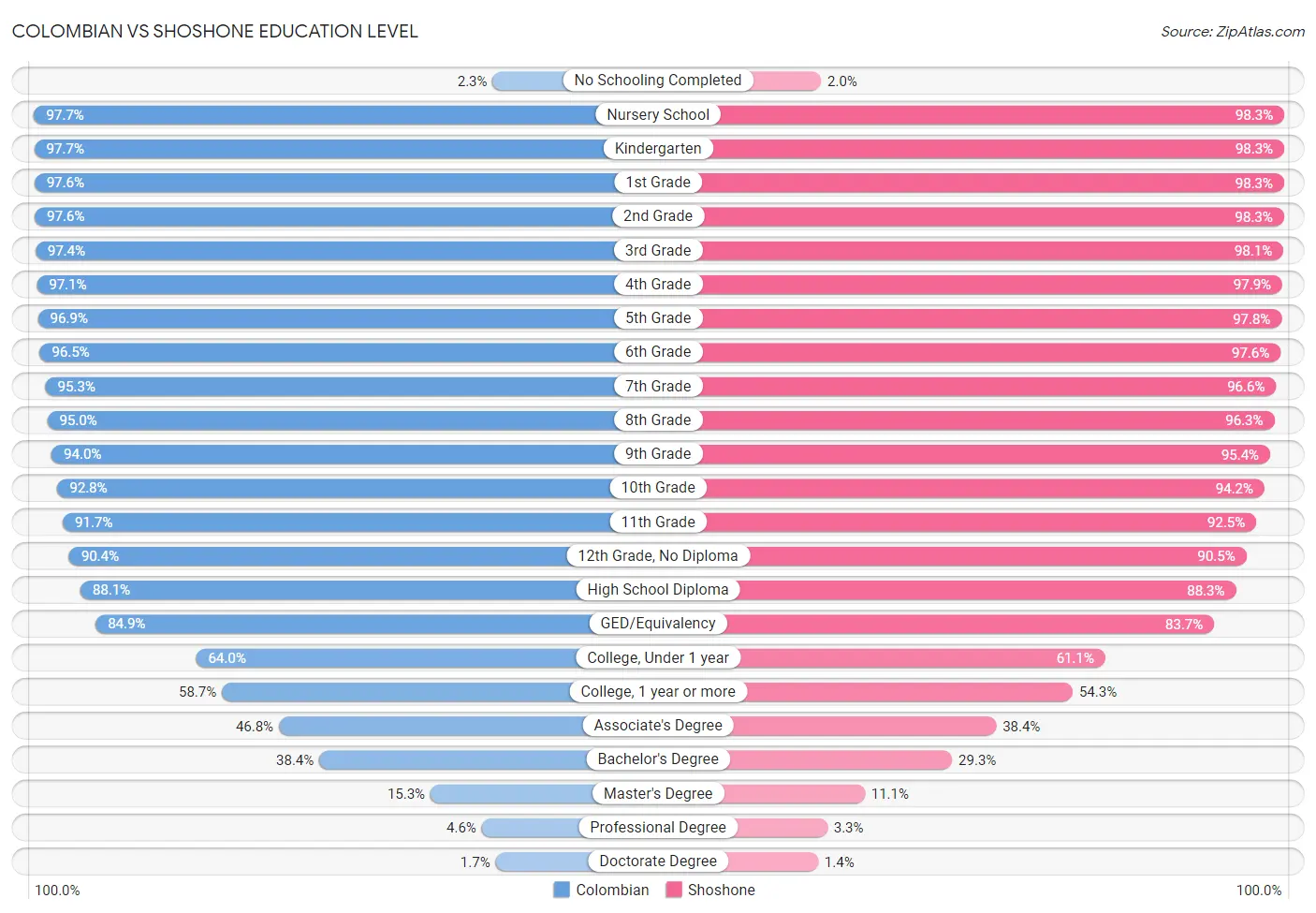
| Education Level Metric | Colombian | Shoshone |
| No Schooling Completed | Tragic 2.3% | Good 2.0% |
| Nursery School | Tragic 97.7% | Exceptional 98.3% |
| Kindergarten | Tragic 97.7% | Exceptional 98.3% |
| 1st Grade | Tragic 97.6% | Exceptional 98.3% |
| 2nd Grade | Tragic 97.6% | Exceptional 98.3% |
| 3rd Grade | Tragic 97.4% | Exceptional 98.1% |
| 4th Grade | Tragic 97.1% | Exceptional 97.9% |
| 5th Grade | Tragic 96.9% | Exceptional 97.8% |
| 6th Grade | Tragic 96.5% | Exceptional 97.6% |
| 7th Grade | Tragic 95.3% | Exceptional 96.6% |
| 8th Grade | Tragic 95.0% | Exceptional 96.3% |
| 9th Grade | Tragic 94.0% | Exceptional 95.4% |
| 10th Grade | Tragic 92.8% | Exceptional 94.2% |
| 11th Grade | Tragic 91.7% | Average 92.5% |
| 12th Grade, No Diploma | Tragic 90.4% | Tragic 90.5% |
| High School Diploma | Tragic 88.1% | Tragic 88.3% |
| GED/Equivalency | Poor 84.9% | Tragic 83.7% |
| College, Under 1 year | Poor 64.0% | Tragic 61.1% |
| College, 1 year or more | Fair 58.7% | Tragic 54.3% |
| Associate's Degree | Good 46.8% | Tragic 38.4% |
| Bachelor's Degree | Good 38.4% | Tragic 29.3% |
| Master's Degree | Good 15.3% | Tragic 11.1% |
| Professional Degree | Good 4.6% | Tragic 3.3% |
| Doctorate Degree | Poor 1.7% | Tragic 1.4% |
Colombian vs Shoshone Disability
When considering disability, the most significant differences between Colombian and Shoshone communities in the United States are seen in hearing disability (2.7% compared to 4.0%, a difference of 46.9%), disability age 35 to 64 (9.9% compared to 14.5%, a difference of 46.4%), and disability age 18 to 34 (5.9% compared to 7.8%, a difference of 32.7%). Conversely, both communities are more comparable in terms of disability age 5 to 17 (5.5% compared to 5.6%, a difference of 2.5%), cognitive disability (16.6% compared to 17.3%, a difference of 4.0%), and disability age over 75 (46.7% compared to 49.9%, a difference of 6.7%).
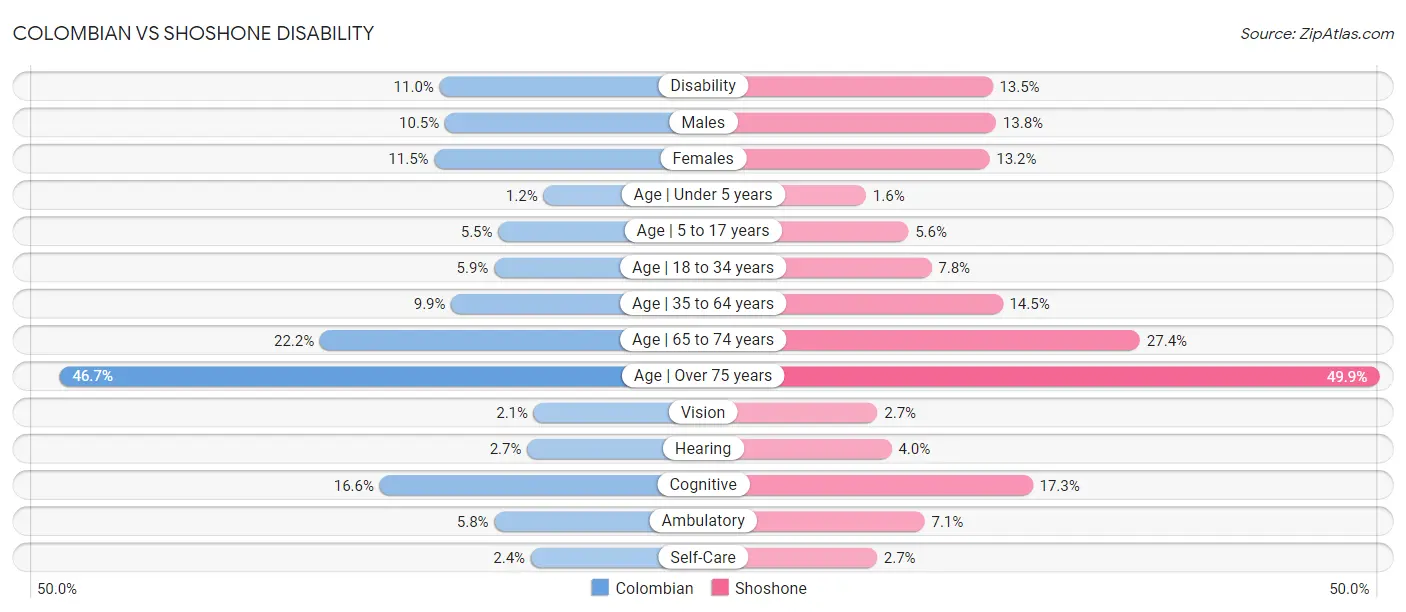
| Disability Metric | Colombian | Shoshone |
| Disability | Exceptional 11.0% | Tragic 13.5% |
| Males | Exceptional 10.5% | Tragic 13.8% |
| Females | Exceptional 11.5% | Tragic 13.2% |
| Age | Under 5 years | Good 1.2% | Tragic 1.6% |
| Age | 5 to 17 years | Excellent 5.5% | Average 5.6% |
| Age | 18 to 34 years | Exceptional 5.9% | Tragic 7.8% |
| Age | 35 to 64 years | Exceptional 9.9% | Tragic 14.5% |
| Age | 65 to 74 years | Exceptional 22.2% | Tragic 27.4% |
| Age | Over 75 years | Exceptional 46.7% | Tragic 49.9% |
| Vision | Good 2.1% | Tragic 2.7% |
| Hearing | Exceptional 2.7% | Tragic 4.0% |
| Cognitive | Exceptional 16.6% | Average 17.3% |
| Ambulatory | Exceptional 5.8% | Tragic 7.1% |
| Self-Care | Excellent 2.4% | Tragic 2.7% |